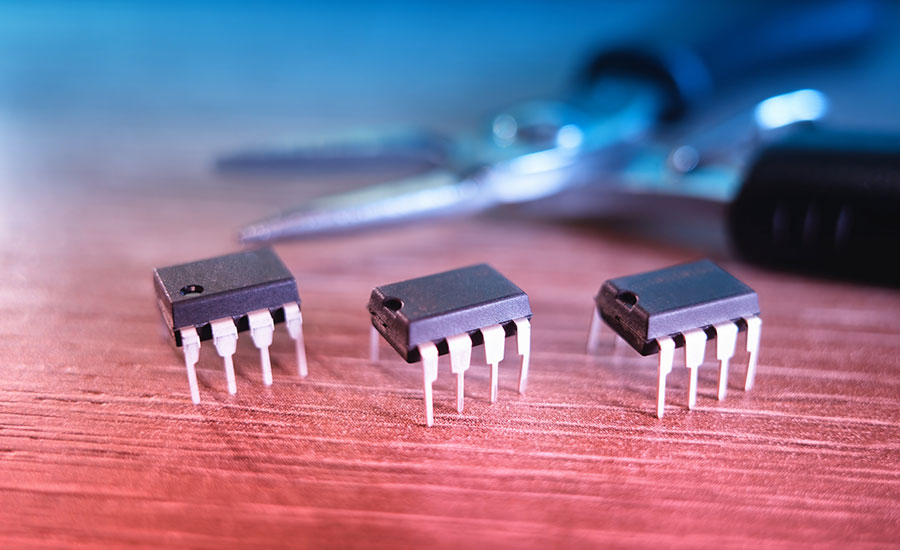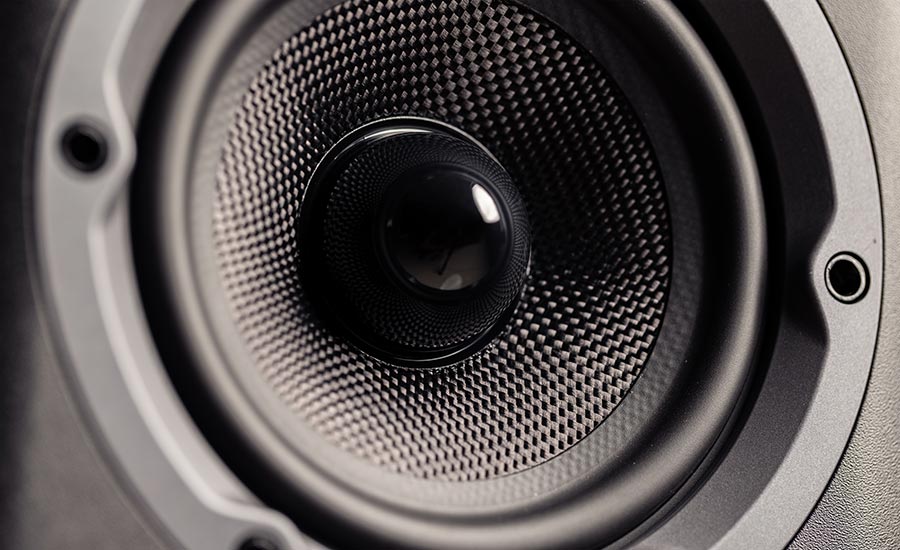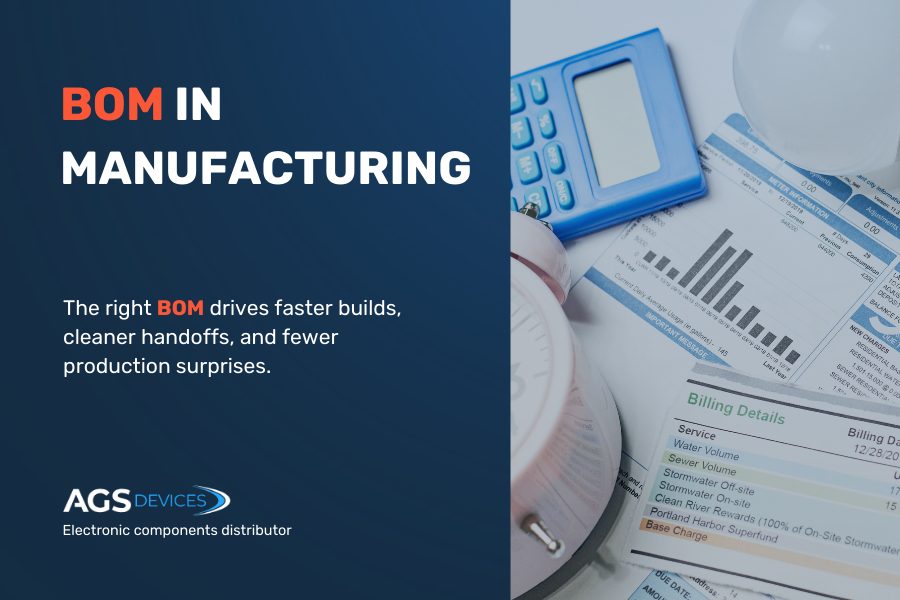
Operational amplifiers, commonly known as op-amps, are crucial components in modern electronics, serving a wide range of applications.
Projected to reach over USD 8 billion by 2031, the operational amplifier market is experiencing a steady CAGR of 4.70%, driven by increasing demand across various sectors, including consumer electronics, automotive electronics, and healthcare.
In this article, we’ll explore the fundamentals of op-amps, their types, applications, and key uses.
What Is an Operational Amplifier?
An operational amplifier is a fundamental building block in modern electronic circuits. This versatile component is designed to amplify voltage and is used in many applications, ranging from simple signal amplification to complex electronic functions.
Op-amps are essential in industries such as audio engineering, instrumentation, and control systems due to their reliability and precision.
Understanding their operation and diverse functions is crucial for anyone in electronics, as they are key to ensuring optimal performance and efficiency in electronic devices.
Their Importance in Modern Electronics
Op-amps are indispensable in modern electronics, providing the precision and versatility needed for tasks like signal processing, filtering, and analog computing.
Their ability to perform essential mathematical operations makes them crucial in a variety of applications, from consumer electronics to industrial automation, ensuring accurate and efficient circuit performance.
The significance of op-amps in the electronics industry is further highlighted by the market’s impressive growth trajectory, spotlighting their continued relevance and essential role in modern technology.
5 Core Functions of Operational Amplifiers
Operational amplifiers are highly versatile because they can perform several essential functions with great precision. When combined with external components like resistors and capacitors, they enable a wide variety of circuit configurations.
1. Amplification: Boosting Signal Strength
The most prominent function of an operational amplifier is signal amplification. It can magnify the strength of an input signal, making weak signals detectable or boosting audio signals to drive speakers.
This amplification can be precisely controlled using external resistors, allowing for gains ranging from small boosts to substantial increases.
2. Mathematical Operations: The Analog Computer
Op-amps excel at performing mathematical operations on analog signals. By carefully configuring external components, you can create circuits that:
- Add multiple input signals together
- Subtract one signal from another
- Integrate a signal over time, essentially calculating its area under the curve
- Differentiate a signal, determining its rate of change
These mathematical capabilities make op-amps essential in analog computing, signal processing, and control systems.
3. Oscillators and Waveform Generation
Op-amps are key components in oscillator circuits, which generate periodic signals like sine waves, square waves, and triangle waves. These signals are used in a wide range of applications, including:
- Timing and clock generation: Providing timing signals for digital circuits and systems.
- Audio synthesis: Creating sounds and musical tones.
- Signal generation for testing: Providing test signals for electronic circuits and systems.
4. Filtering: Shaping the Frequency Spectrum
Op-amps are key components in filter circuits, which selectively allow or block specific frequencies within a signal. By combining op-amps with resistors and capacitors, you can create:
- Low-pass filters: Allowing low frequencies to pass through while reducing high frequencies.
- High-pass filters: Allowing high frequencies to pass while blocking low frequencies.
- Band-pass filters: Allowing a specific range of frequencies to pass while reducing others.
- Band-stop filters: Blocking a specific range of frequencies while allowing others to pass.
These filtering capabilities are vital in audio engineering, telecommunications, and medical instrumentation.
5. Comparison: Detecting Voltage Levels
Op-amps can also function as comparators, comparing two input voltages and producing an output that indicates which voltage is higher. This function is essential in:
- Zero-crossing detectors: Detecting when a signal crosses zero volts.
- Threshold detectors: Triggering an output when a signal exceeds a certain voltage level.
- Analog-to-digital converters (ADCs): Converting analog signals to digital representations.
Types of Op-Amps
As the versatile workhorses of analog circuits, many varieties of op-amps are available, each carefully designed to meet specific application needs and performance demands.
Understanding the different types of op-amps is crucial for selecting the right component for your electronic design.
Categorization Based on Gain: Low, Medium, and High
One common way to classify op-amps is by their gain characteristics. This helps determine the amplifying power of the op-amp and its suitability for various signal processing tasks.
Low Gain Amplifiers
These op-amps, as the name suggests, have a relatively low gain value, typically less than 10. They are often used for impedance matching and buffering applications. In impedance matching, they provide efficient signal transfer between circuits with different impedance levels.
As buffers, they isolate the input signal from the load, preventing loading effects.
Medium Gain Amplifiers
Op-amps with a moderate gain, typically ranging from 10 to 100, fall under this category. These are the most common type of op-amps and are used in various circuits, including audio amplifiers, active filters, and signal conditioning circuits.
They provide sufficient amplification for many common signals without introducing excessive noise or distortion.
High Gain Amplifiers
Op-amps with very high gain, often exceeding 100,000, are classified as high gain amplifiers. They excel in amplifying extremely weak signals, making them suitable for applications like sensor interfaces, instrumentation amplifiers, and medical equipment.
However, high gain amplifiers can be more susceptible to noise and instability, requiring careful circuit design considerations.
Specialized Op-Amps for Specific Applications
Beyond gain, op-amps are also specialized for specific purposes.
Precision Op-Amps
Precision op-amps are designed for applications requiring high accuracy and low noise. They feature very low input offset voltage, low drift, and high common-mode rejection ratio (CMRR).
These op-amps are ideal for instrumentation, sensor interfaces, and high-precision measurement systems. Examples include the OP07 and AD620 series.
High-Speed Op-Amps
High-speed op-amps are optimized for applications requiring fast signal processing.
They offer high slew rates and wide bandwidths, making them suitable for video processing, high-speed data acquisition, and RF applications. The AD8099 and LMH6702 are among the most common examples of high-speed op-amps.
Low-Noise Op-Amps
Low-noise op-amps are designed to minimize internal noise generation, making them ideal for audio applications, sensitive sensor interfaces, and low-level signal amplification.
This type of operational amplifier typically has very low input noise voltage and current. Common examples of low-noise op-amps include the OPA1612 and AD797.
Rail-to-Rail Op-Amps
These op-amps can swing their output voltage very close to the supply rails, maximizing the output voltage range and improving efficiency in low-voltage applications.
The AD8605 and MCP6001 are the most common examples of rail-to-rail op-amps.
Current-Feedback Op-Amps
Unlike traditional voltage-feedback op-amps, current-feedback op-amps offer a nearly constant bandwidth that is less dependent on gain.
This makes them particularly useful in high-frequency applications and video processing. The AD8001 and LT1395 are examples of current-feedback op-amps.
Micropower Op-Amps
Micropower op-amps are designed for ultra-low power consumption, making them ideal for battery-powered and portable devices.
While they may sacrifice some performance parameters, they excel in extending battery life in low-power applications. The LPV521 and AD8500 are the most common examples of micropower op-amps.
Chopper-Stabilized Op-Amps
Chopper-stabilized (also known as zero-drift) op-amps use a special technique to minimize input offset voltage and drift over time and temperature.
They are excellent for precision DC and low-frequency applications where long-term stability is crucial. The LTC2050 and ADA4522 are common examples of chopper-stabilized op-amps.
Key Uses of Operational Amplifiers in Electronics
The operational amplifier has become an indispensable component in different electronic circuits, revolutionizing various industries and applications. Its versatility, precision, and reliability make it ideal for complex systems where signal processing and control are crucial.
Let’s explore some of the key areas where op-amps shine:
Analog Computers
Op-amps were initially developed for use in analog computers, where they were employed to perform mathematical operations like addition, subtraction, integration, and differentiation. These operations were essential for solving differential equations and simulating complex systems.
While digital computers have largely replaced analog computers for general-purpose computing, op-amps continue to be used in specialized analog computing applications, particularly in areas like control systems and signal processing.
Audio Equipment
An operational amplifier often finds its use in audio equipment, including amplifiers, mixers, equalizers, and filters. In audio amplifiers, op-amps are used to boost weak signals from microphones or other audio sources to a level suitable for driving speakers.
Mixers use op-amps to combine multiple audio signals, while equalizers employ op-amps to adjust the frequency response of an audio signal. Filters, built using op-amps, are used to remove unwanted noise or frequencies from audio signals, ensuring clear and high-quality sound reproduction.
Examples of op-amps in audio circuits:
- Preamplifiers: Boosting weak microphone signals.
- Power Amplifiers: Driving speakers with amplified audio.
- Active Filters: Shaping the tonal characteristics of audio.
- Tone Controls: Allowing users to adjust bass, treble, etc.

Control Systems and Instrumentation
Control systems rely heavily on op-amps for tasks such as signal conditioning, feedback control, and sensor interfacing. Op-amps are used to amplify and filter sensor signals, making them suitable for processing by control circuits.
In feedback control systems, op-amps are used to compare the desired output with the actual output and generate an error signal that drives the system towards the desired state.
Instrumentation applications often use op-amps for tasks like amplifying weak signals from sensors, converting signals from one form to another (e.g., voltage to current), and implementing control algorithms.
Op-amps in control systems:
- PID Controllers: Implementing proportional, integral, and derivative control actions.
- Motor Control: Regulating speed, position, and torque of motors.
- Temperature Control: Maintaining a desired temperature in ovens, refrigerators, etc.
Power Management and Conversion
Op-amps are also employed in power management and conversion circuits, such as voltage regulators, switching power supplies, and battery chargers. Voltage regulators utilize op-amps to maintain a stable output voltage despite variations in input voltage or load current.
Switching power supplies use op-amps in control circuits to regulate the switching frequency and duty cycle, achieving high efficiency in power conversion. Battery chargers employ op-amps to control the charging current and voltage, ensuring safe and efficient battery charging.
Examples of op-amps in power electronics:
- Linear regulators: Providing a stable DC voltage output.
- Switching regulators: Efficiently converting voltage levels.
- Battery management systems: Monitoring and controlling battery charging and discharging.
These are just a few examples of the many applications of operational amplifiers in electronic circuits. Their versatility, low cost, and ease of use have made them indispensable components in a wide range of electronic devices, contributing significantly to the functionality and performance of modern electronics.

Choosing the Right Op-Amp: A Short Guide
Selecting the ideal operational amplifier for your project involves carefully considering several key parameters to achieve optimal performance.
Here’s a step-by-step guide to help you choose the right one:
Step #1: Determine Operating Voltage Range
Begin by identifying the voltage range your circuit will operate within. Check the operational amplifier’s datasheet for its power supply voltage ratings to ensure compatibility.
Consider whether you need a single or dual supply op-amp based on your circuit’s output voltage requirements.
Step #2: Consider Gain Bandwidth Product (GBP)
GBP is a key indicator of an operational amplifier’s performance at higher frequencies. For high-speed or high-precision applications, opt for op-amps with higher GBP values.
Note that higher GBP often comes with increased power consumption.
Step #3: Evaluate Power Consumption
Power consumption is crucial, especially for battery-powered devices. Datasheets list supply current and power consumption, allowing you to estimate power requirements.
Generally, op-amps with lower supply currents consume less power but may have lower GBP and performance.
Step #4: Assess Input Offset Voltage
When accuracy is paramount, pay close attention to the input offset voltage.
This parameter indicates the voltage difference between input terminals required to nullify the output. Lower offset voltage translates to higher accuracy.
Step #5: Factor in Other Parameters
Depending on your specific needs, consider additional parameters like noise levels, slew rate, input bias current, and common-mode rejection ratio.
Carefully analyze the datasheet to find an operational amplifier that meets your project’s unique requirements.
How AGS Devices Can Support Your Op-Amp Needs
At AGS Devices, we recognize the critical role operational amplifiers play in your electronic designs. That’s why we’re committed to providing the highest quality op-amps, ensuring your projects meet the most demanding performance standards.
Our extensive inventory features an impressive range of op-amps from leading manufacturers, catering to various applications.
We also offer expert technical support, helping you select the ideal operational amplifier for your specific needs, along with a broad selection of other essential electronic components, including:
- Power Supply Distributors
- Semiconductors for Sale
- Optoelectronics
- Circuit Protection
- Interconnects
- Passive Components Electronics
- Electronic Testing Equipment
- Electromechanical Devices
Partner with AGS Devices for reliable sourcing, technical expertise, and a commitment to delivering the best operational amplifier solutions for your success.

